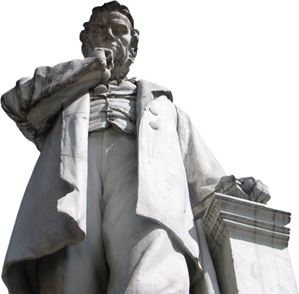As cars, buses and motorbikes hurtle by in via San Agostino, a white marble monument seems defenceless as it stands precariously on the southern tip of Florence’s piazza Santo Spirito. Deep in thought, with one hand under his chin and the other resting on a book perched on top of a draped pedestal, the elegantly dressed man in the statue seems oblivious to any impending danger surrounding him. Placed in the piazza in 1898, the sculpture is the work of Raffaello Romanelli, one of a still-existing dynasty of Florentine sculptors whose work includes the bust of Benvenuto Cellini on the Ponte Vecchio. The inscription on pink marble at the base of statue tells us we are looking at the agronomist and politician Cosimo Ridolfi, who was ‘an outstanding teacher of the great agrarian disciplines and the untiring promoter of Italian farmers.’
Cosimo Ridolfi, the son of Marchese Luigi Ridolfi and his wife, Anastasia Frescobaldi, was born in Florence on November 28, 1794, into an old and privileged aristocratic family. When Cosimo was six, his father died. His mother not only oversaw his academic education but ensured that the boy spent time out in the open air on the family estate at Meleto, near Castelfiorentino in Val d’Elsa. There he quickly developed a love of the land and under the tutelage of the estate manager, Agostino Testaferrata, learnt the basics of agronomy, which he soon supplemented by studying physics, chemistry, botany, economics and geography.

In 1813, at just 19, Ridolfi became a member of the prestigious scientific Accademia dei Georgofili (in 1842, he became its president, remaining in that position until his death over two decades later). Eager to learn about the latest innovations in agriculture, many of which had evolved during the Industrial Revolution, in 1820, he travelled widely throughout England and the continent. In 1825, he became director of the Mint in Florence, where he introduced a new decimal monetary system, and, in 1828, of the Workhouse; however, because of a difference of opinion with the government of Grand Duke Leopold II of Lorraine, he resigned both posts in 1830. Shortly before this, in 1827, he had been elected gonfaloniere of Capraia. That same year, together with Raffaello Lambruschini and Giovan Pietro Vieusseux, he launched the Giornale Agrario della Toscana to propagate the results of current agrarian research in a period when a sharp rise in population was causing food shortages not only in Tuscany but throughout Europe.
To encourage investment in farming, in 1828, he took steps to set up a savings bank at his palace in via Maggio. Inaugurated on June 29, 1829, with Ridolfi as its first president, this became the Cassa di Risparmio of Florence, a bank that is still today one of the most important financial institutions in the city. In the 1830s, with the idea of improving the economic, social and moral lot of peasant farmers, he established a hands-on agricultural school on his model farm at Meleto to train the local children in estate management. Made professor of agronomy at University of Pisa in 1840, he convinced the grand duke, in 1842, to convert this into the first Italian Faculty of Agriculture, where he presided and taught. In 1845, the grand duke appointed him as his son’s tutor.
The 1840s, however, brought tumultuous political times marked by popular uprisings and calls for democratic reforms. In 1846, even the loyal and moderate Ridolfi joined other liberal Tuscans in petitioning the grand duke to institute sweeping agricultural reform. In a period when governments in Tuscany came and went because they were unable to stem the tide of unrest, he served as minister of the interior in 1847 and then, briefly, prime minister. The next short-lived cabinet of Gino Capponi sent Ridolfi as an ambassador to London and Paris in 1848, but he was unable to muster enough support to prevent Leopold II from being deposed in 1849. Opposing Francesco Domenico Guerrazzi’s intervening dictatorship, Ridolfi was also against the Austrian intervention that restored the monarch to the throne, so he retired from political life. Only in 1859, after a bloodless coup expelled Leopold II for good, did he return to public office, becoming Tuscany’s minister of education and interim foreign minister. In 1860, he was nominated senator in the newly founded Kingdom of Italy. On March 5, 1865, stone deaf and racked with headaches and stomach cramps, Ridolfi died, aged 71, surrounded by his family.
Just a little over 40 years earlier, Ridolfi had married Luisa Guicciardini, who worked at his side throughout his life. They had three children. Their eldest son, Luigi Ridolfi (1895–1958), founded both the Maggio Musicale Fiorentino and the ACF Fiorentina football club: the central training ground for Italian soccer teams at Coverciano, on the outskirts of Florence, is named after him.








